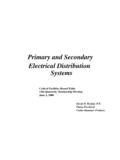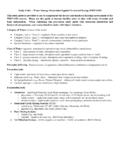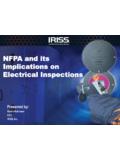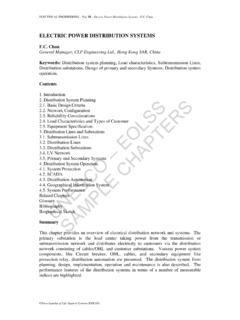Transcription of NFPA 70 and its Implications on Electrical Inspections
1 NFPA 70 and its Implications on Electrical Inspections By: Martin Robinson, Level III Thermographer 18-1030-0007 Rev. A The National Fire Protection Association (NFPA) was established in 1896 and has become the world s leading advocate of fire prevention. The influence of its 300 codes and standards are evident in buildings, products, and practices throughout the world. NFPA codes are adopted through a broad consensus of experts, and have resulted in some of the world s most referenced and respected codes. NFPA 70, also known as the National Electric Code (NEC) is the standard developed for Electrical design, installation and inspection . It does not specifically address Electrical maintenance or safe work practices. For the consensus standards on these topics we turn to NFPA 70B and NFPA 70E respectively.
2 Although NFPA has no regulatory authority, its codes and standards are widely adopted or referenced by agencies such as local municipalities and OSHA many times making the standards a de-facto regulatory requirement for companies. In fact, in August 2007, OSHA adopted aspects of NFPA 70E and the NEC in a rare revision to its (OSHA s) Subpart S, stating that the agency will draw heavily from the 2000 edition of NFPA 70E, as well as the 2002 edition of the NEC. In other instances, insurers may reference standards as best management practices and may even require aspects of these standards as a requirement for better rates or perhaps as a prerequisite for insurability. Many insurers are requiring manufacturers to inspect their critical Electrical distribution equipment at least annually, per NFPA 70B.
3 Dangers of Arc Flash One of the dangers which these standards are designed to mitigate is the risk of an Electrical arc flash. An arc flash is a short circuit (a phase-to-phase or phase-to-ground fault) through the air. Arc flash incidents can be triggered by a variety of electro-mechanical and accidental causes including: dust, corrosion and impurities on contact surfaces; racking of breakers and replacement of fuses; failure of insulating material; leads breaking at connections; accidental contact with conductors with body, tools, bolts or other metal parts. The arc flash itself can achieve temperatures in excess of 35,000F, producing a blinding flash, causing copper bus-bar and cabling to instantly reach a plasma state (the fourth state of matter after liquid and gas) which causes copper to expand more than 67,000 times its solid-state size.
4 This resulting arc blast is a bomb-like explosion which releases thousands of pounds of force, carrying with it molten shrapnel and a super-heated fireball which will often blow steel panels off hinges and bolts. The net result can be total destruction of any plant assets in direct contact with the explosion, and disruption of plant processes. If a thermographer, electrician or laborer happens to be working in front of the equipment which is affected by the blast, the effects for the worker and their families could be devastating. The heat generated by the arc flash can cause 3rd degree burns. The pressure wave from the explosion can rupture internal organs, damage hearing and cause injuries if the worker is thrown into surroundings predominated by concrete and steel.
5 The shrapnel and flying panels can have obvious effects as they rip through the air and potentially through any people in the vicinity of the explosion. Each year across North America, 5 to 10 serious arc flash incidents occur each day, resulting in the need to treat over 2,000 workers in burn centers (it is estimated that many more occur which only require emergency room attention and therefore do not get categorized in studies). The financial costs of flash accident are estimated in the hundreds-of -millions of dollars a year, while the effects on those workers and the lives of their families cannot be represented in mere dollars and cents. NFPA 70B NFPA 70B is a standard for implementing an effective Electrical Preventive Maintenance (EPM) program.
6 The purpose of an EPM program is to reduce hazard to life and property that can result from the failure or malfunction of Electrical systems and equipment. It states that a well-administered EPM program will reduce accidents, save lives, and minimize costly breakdowns and unplanned shutdowns of production an EPM program, management assumes a greatly increased risk of a serious Electrical failure and its consequences. 70B goes on to state that dependability can be engineered and built into equipment, but effective maintenance is required to keep it dependable. Electrical equipment deterioration is normal, but equipment failure is not inevitable. As soon as new equipment is installed, a process of normal deterioration begins. Unchecked, the deterioration process can cause malfunction or an Electrical An effective EPM program identifies and recognizes these factors and provides measures for coping with them.
7 70B outlines the following benefits of an EPM program: Asset Protection: Experience shows that equipment lasts longer and performs better when covered by an EPM program. Risk Management: An EPM program is a form of protection against accidents, lost production, and loss of profit. Energy Conservation: Equipment that is well maintained operates more efficiently and utilizes less energy. Increased uptime and profitability: through reduced interruption of production and better workmanship and increased productivity. Improved employee morale and reduced absenteeism Possible reduction in insurance costs: due to the alternative high cost of inadequate maintenance. NFPA regards systematic and regular thermographic Electrical Inspections to be a critical part of an EPM program stating that these [thermographic] Inspections have uncovered a multitude of potentially dangerous situations.
8 Proper diagnosis and remedial action of these situations have also helped to prevent numerous major can reduce typical visual examinations and tedious manual Inspections and are especially effective in long-range detection situations. It goes on to endorse T Range Interpretation Prescriptive Action 1 C ( F) to 3 C ( F) Indicates Possible Deficiency warrant investigation 4 C ( F) to 15 C (27 F) Indicates Deficiency repairs should be made as time permits 16 C ( F) and above Indicates Major Deficiency repairs should be made immediately Thermographic Electrical inspection as relatively inexpensive to use considering the savings often realized by preventing equipment damage and business [and is] considered a useful tool to evaluate previous repair work and proof test new Electrical installations and new equipment still under warranty.
9 The 70B standard prescribes routine infrared Inspections of energized Electrical systems should be performed annually prior to shutdown. More frequent infrared Inspections , for example, quarterly or semiannually, should be performed where warranted by loss experience, installation of new Electrical equipment, or changes in environmental, operational, or load conditions. 70B also prescribes temperature benchmarking and references the NETA benchmarks as seen in Table 1. The NETA table compares temperatures to normal (as determined by a qualified technician ) and prescribes a corrective action based on those deviations from normal. It is important to remember that temperature (T) and differential temperature ( T) measurements are only as accurate as the optic through which the object is being viewed.
10 Therefore, it is imperative that users of infrared windows or viewing panes compensate for any attenuation in transmission. The standard is also very specific about performing running Inspections ( Inspections made with equipment operating) and requires that infrared surveys should be performed during periods of maximum possible loading but not less than 40 percent of rated load of the Electrical equipment being inspected. In instances where IR Windows or viewing panes are not available, equipment enclosures should be opened for a view of components whenever since it is not possible for infrared imagers to calculate internal temperatures through standard panel covers or standard materials used in visual inspection panes ( Tempered glass or Plexiglas) as these materials are non-transmissive in the infrared spectrum.







